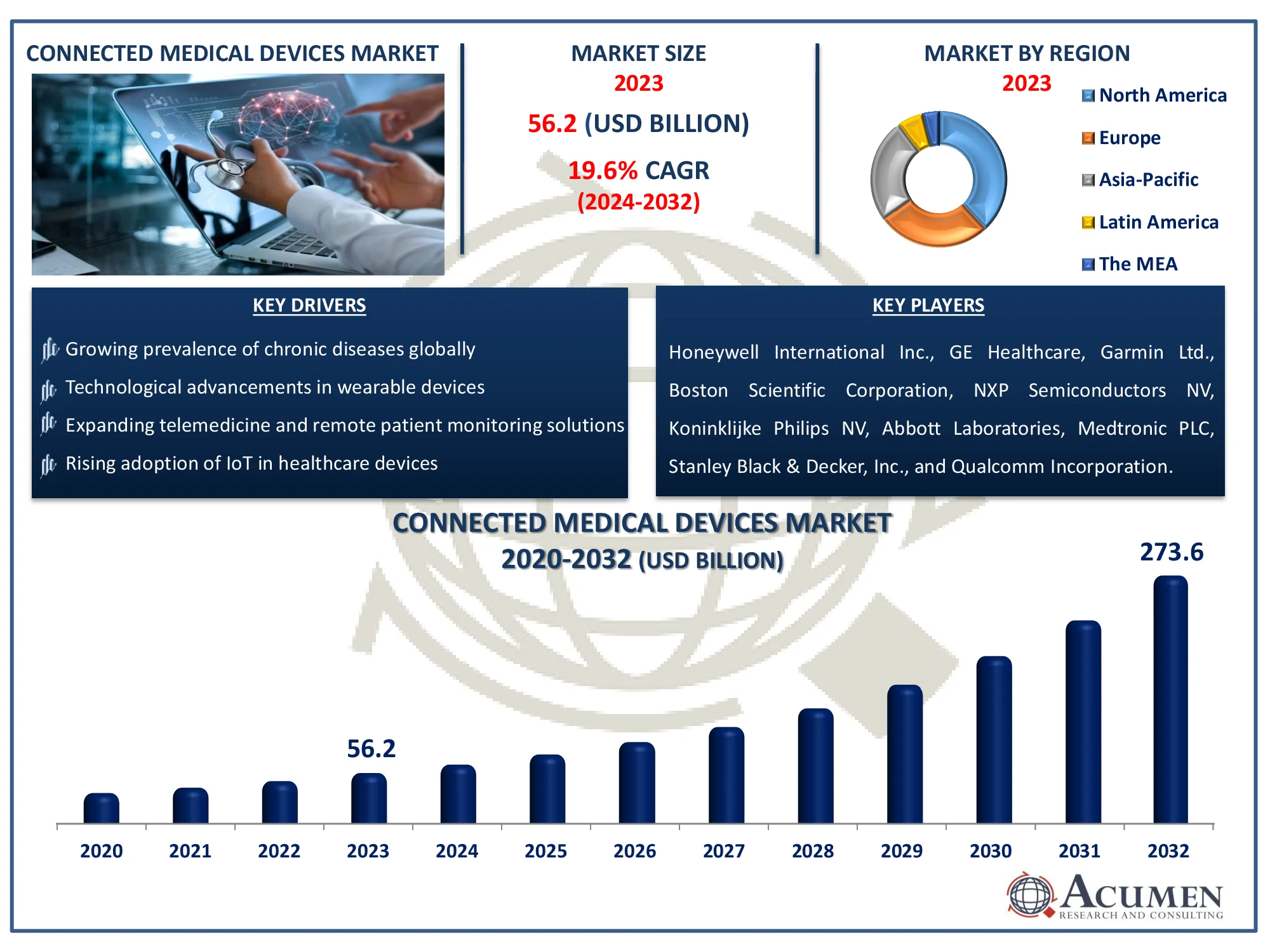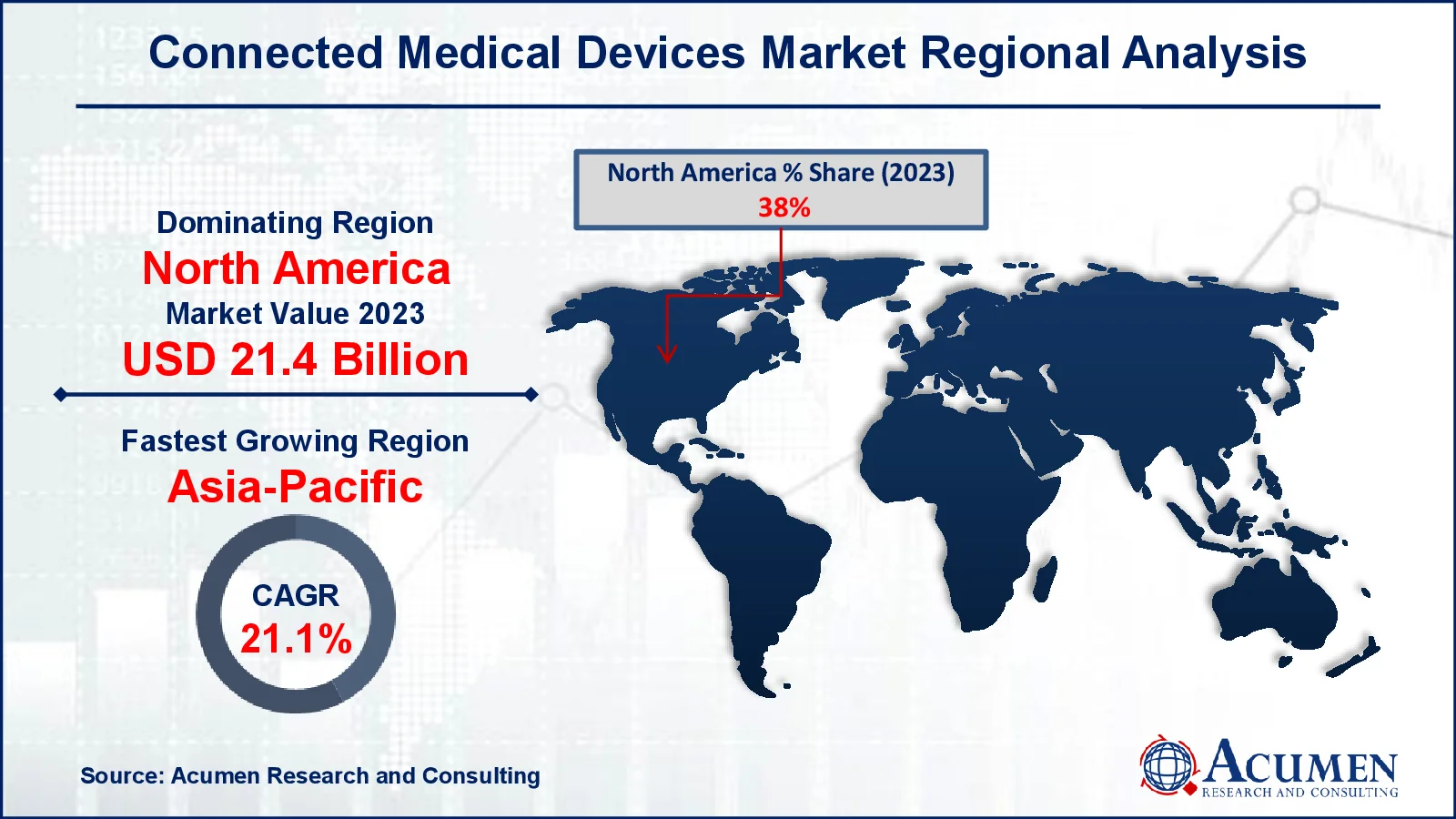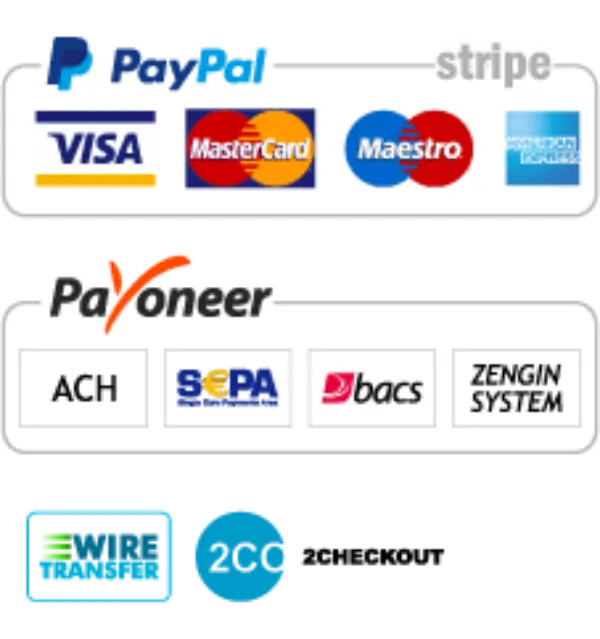Connected Medical Devices Market Size - Global Industry, Share, Analysis, Trends and Forecast 2024 - 2032
Published :
Report ID:
Pages :
Format :
Connected Medical Devices Market Size - Global Industry, Share, Analysis, Trends and Forecast 2024 - 2032
Report Coverage
- Industry Dynamics
- Market Size and Forecast Data
- Segment Analysis
- Competitive Landscape
- Regional Analysis with a Niche Focus on Country-Level Data
- High Level Analysis - Porter's, PESTEL, Value Chain, etc.
- Company Profiles of Key Players
- Option to Customize the Report As Per Your Specific Need
Request Sample Report
The Global Connected Medical Devices Market Size accounted for USD 56.2 Billion in 2023 and is estimated to achieve a market size of USD 273.6 Billion by 2032 growing at a CAGR of 19.6% from 2024 to 2032.
Connected Medical Devices Market Highlights
- Global connected medical devices market revenue is poised to garner USD 273.6 billion by 2032 with a CAGR of 19.6% from 2024 to 2032
- North America connected medical devices market value occupied around USD 21.4 billion in 2023
- Asia-Pacific connected medical devices market growth will record a CAGR of more than 21.1% from 2024 to 2032
- Among end-user, the hospitals sub-segment generated more than USD 25.9 billion revenue in 2023
- Based on application, the remote monitoring generated around 45% connected medical devices market share in 2023
- Rising investments in AI-powered healthcare solutions is a popular connected medical devices market trend that fuels the industry demand

The market for connected medical devices is one of the emerging disciplines of medicine that has been continuously growing over the last decade. Connected medical devices offer numerous advantages, including automated alarms, remote monitoring, accurate intervention, cheaper healthcare costs, and, most significantly, improved patient outcomes. These devices can be a highly useful solution for enhancing patient health when secured properly and maintained.
Connected medical devices are medical devices that are linked to data collection and monitoring systems via computers, smartphones, and other devices. In addition to earlier detection and prediction, connected medical devices can track the effectiveness of patient outcomes. This gives clinicians more precise and consistent data about their patients, as well as better results. Additionally, expanding the generic population, increased acceptance of connectivity options, increased internet penetration, and considerable expansion in IoT technology across medical products are the key factors that drive global demand for connected medical devices.
Global Connected Medical Devices Market Dynamics
Market Drivers
- Rising adoption of IoT in healthcare devices
- Growing prevalence of chronic diseases globally
- Technological advancements in wearable devices
- Expanding telemedicine and remote patient monitoring solutions
Market Restraints
- Concerns about data security
- The high cost of connected medical devices
- Interoperability challenges between different healthcare systems
Market Opportunities
- Increasing adoption of home medical equipment
- Digitalization in the healthcare sector
- Expansion of 5G networks to enhance device connectivity
Connected Medical Devices Market Report Coverage
|
Market |
Connected Medical Devices Market |
|
Connected Medical Devices Market Size 2023 |
USD 56.2 Billion |
|
Connected Medical Devices Market Forecast 2032 |
USD 273.6 Billion |
|
Connected Medical Devices Market CAGR During 2024 - 2032 |
19.6% |
|
Connected Medical Devices Market Analysis Period |
2020 - 2032 |
|
Connected Medical Devices Market Base Year |
2023 |
|
Connected Medical Devices Market Forecast Data |
2024 - 2032 |
|
Segments Covered |
By Product, By Application, By End-User, and By Geography |
|
Regional Scope |
North America, Europe, Asia Pacific, Latin America, and Middle East & Africa |
|
Key Companies Profiled |
Honeywell International Inc., GE Healthcare, Garmin Ltd., Boston Scientific Corporation, NXP Semiconductors NV, Koninklijke Philips NV, Abbott Laboratories, Medtronic PLC, Stanley Black & Decker, Inc., and Qualcomm Incorporation. |
|
Report Coverage |
Market Trends, Drivers, Restraints, Competitive Analysis, Player Profiling, Covid-19 Analysis, Regulation Analysis |
Connected Medical Devices Market Insights
Advancements in technology, raising occurrence rates of chronic diseases such as genetic diseases, COPD, respiratory diseases, and others, improved access to high-speed internet, and the implementation of favorable government regulatory policies are the major factors driving the growth of the connected medical devices market. Furthermore, due to the accessibility of web-connected devices and feasible networks, consumers and healthcare providers can now use connected medical devices for examinations and monitoring the patient. Such devices can facilitate assessments and assist healthcare professionals in providing appropriate consultation and medication to patients in remote areas. Increased internet penetration among individuals and medical professionals is also assisting connected medical device market growth.
Additionally, the need for cost-cutting in healthcare delivery, as well as a growing emphasis on effective patient engagement and improving patient outcomes, are driving the growth of the market. Furthermore, federal programs to promote digitalization in healthcare are expected to drive demand growth in the industry over the connected medical devices market forecast period.
 Connected Medical Devices Market Segmentation
Connected Medical Devices Market Segmentation
The worldwide market for connected medical devices is split based on product, application, end-user, and geography.
Connected Medical Device Market By Product
- Heart Rate Monitor
- Smart Pill Dispenser
- Portable GPS PERS
- Insulin Pump
- Pulse Oximeter
- ECG Monitoring Devices
- Glucose Monitor
- BP Monitor
- Others
According to connected medical devices industry analysis, based on the product, ECG monitoring devices are expected to grow significantly in the market over the next few years. An electrocardiogram (ECG) monitoring device is a device that records heart activity using electric signals that are amplified on an ECG monitor. Over the forecast period, the market for ECG monitoring devices will be driven by advancements in IoT-based ECG monitoring systems and an increase in the global disease burden. Furthermore, factors such as a growing emphasis on patient-centric care delivery, an increase in smartphone and high-speed networking and connectivity solutions penetration, and a growing need to reduce medical costs are driving the growth of the ECG monitoring devices segment in the market.
Connected Medical Device Market By Application
- Remote Monitoring
- Treatment Services
- Fitness
- Consultation and Diagnosis Services
- Wellness Services
Based on the application, remote monitoring is expected to grow significantly in the market over the next few years. Remote monitoring is a technology that collects medical and health-related data from people in one location and sends it digitally to a healthcare provider in another. Remote monitoring is used to remotely analyze physiological indicators such as pulse rate, blood pressure, blood oxygen levels, sugar levels, and any other vital signs, and improving care and quality of life and allowing for early prediction of aggravations and exacerbations. The major factors driving the growth of this segment are advancements in telecommunications, rising chronic disease incidences, growing geriatric population, and increased investments in telehealth and remote monitoring devices.
Connected Medical Device Market By End-User
- Hospitals
- Specialty Clinics
- Home Care Settings/Monitoring
- Ambulatory Surgical Centers
- Others
Hospitals will have the largest share of the global market due to reduced inpatient processing, increased demand for telehealth, and teleconsultation, among other factors. Furthermore, the enormous patient volume, increasing investment in hospitals to purchase modern medical device connectivity solutions, lowering hospital margins, and an increased focus on providing high-quality patient care and safety all contribute to this segment growth in the market. Furthermore, the increased emphasis on remote patient monitoring devices for continuous monitoring of COVID-19 patients, as well as the rising prevalence of various chronic respiratory disorders, is driving the adoption of these devices and services in this segment.
Connected Medical Devices Market Regional Outlook
North America
- U.S.
- Canada
Europe
- U.K.
- Germany
- France
- Spain
- Rest of Europe
Asia-Pacific
- India
- Japan
- China
- Australia
- South Korea
- Rest of Asia-Pacific
Latin America
- Brazil
- Mexico
- Rest of LATAM
The Middle East & Africa
- South Africa
- GCC Countries
- Rest of the Middle East & Africa (ME&A)
 Connected Medical Devices Market Regional Analysis
Connected Medical Devices Market Regional Analysis
The market in North America is expected to have the highest share. The expanding prevalence of IoT-based solutions, a growing generic population, and advanced medical infrastructure are moving the connected medical devices industry forward in the region. The large share of this region can be due to factors such as the presence of large market participants, widespread adoption of clinical remote monitoring, and integration solutions to lower healthcare costs. Also, an increase in the number of corona virus patients in the United States, as well as stringent rules and guidelines imposed by various government and non-government organizations, are driving the regional market forward. Furthermore, the presence of well-established medical device manufacturers, as well as advanced healthcare infrastructures, expansions, and high healthcare expenditures, characterize the US-connected medical device industry.
Connected Medical Devices Market Players
Some of the top connected medical devices companies offered in our report include Honeywell International Inc., GE Healthcare, Garmin Ltd., Boston Scientific Corporation, NXP Semiconductors NV, Koninklijke Philips NV, Abbott Laboratories, Medtronic PLC, Stanley Black & Decker, Inc., and Qualcomm Incorporation.
Frequently Asked Questions
How much was the estimated value of the global connected medical devices market in 2021?
The estimated value of global connected medical devices market in 2021 was accounted to be US$31.2 Bn.
What will be the projected CAGR for global connected medical devices market during forecast period of 2022 to 2030?
The projected CAGR of connected medical devices during the analysis period of 2022 to 2030 is 22.1%.
Which are the prominent competitors operating in the market?
The prominent players of the global connected medical devices market involve Honeywell International Inc., GE Healthcare, Garmin Ltd., Boston Scientific Corporation, NXP Semiconductors NV, Koninklijke Philips NV, Abbott Laboratories, Medtronic PLC, Stanley Black & Decker, Inc, and Qualcomm Incorporation.
Which region held the dominating position in the global connected medical devices market?
North America held the dominating share for connected medical devices during the analysis period of 2022 to 2030.
Which region exhibited the fastest growing CAGR for the forecast period of 2022 to 2030?
Asia-Pacific region exhibited fastest growing CAGR for connected medical devices during the analysis period of 2022 to 2030.
What are the current trends and dynamics in the global connected medical devices market?
Rising adoption of IoT in healthcare devices, the growing prevalence of chronic diseases globally, and technological advancements in wearable devices are the prominent factors that fuel the growth of global connected medical devices market.
By segment product, which sub-segment held the maximum share?
Based on product, ECG monitoring devices segment held the maximum share for connected medical devices market in 2021.


